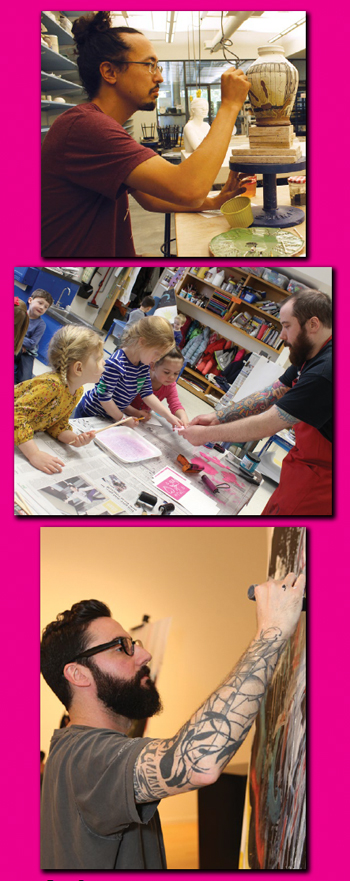The impact of the arts can be seen not only in a community’s economics but also the health and happiness of its people.
| 2018 Q1 | story by Jackie Hedeman, Lawrence Arts Center | photos by ——-

Imagine a world without the arts. Picasso never existed. Neither did Sandra Cisneros, Yo-Yo Ma, Lorraine Hansberry or Ai Weiwei. Clothing is functional, and Broadway is just a road. A world without the arts is nearly unimaginable. However, contemplating the possibility makes me reflect on the many ways the arts improve my well-being. For me, and I’m sure for many of you, access to the arts is intensely beneficial.
It’s easy to greet statements such as this with skepticism. Even for arts lovers, the notion that the arts belong anywhere on Maslow’s hierarchy of needs may not seem intuitive. And yet, study after study has indicated exposure to the arts, whether actively through practice or passively through observation, is of measureable benefit to our mental and physical health. A literature review in the American Journal of Public Health concludes, “Through creativity and imagination, we find our identity and our reservoir of healing.”
Most studies conducted on the relationship between the arts and health focus on specific populations. One study indicates that, because the arts appeal to different learning styles, children who have access to arts education programming demonstrate greater academic success and lower dropout rates, as well as a greater likelihood of civic engagement. Another recent study from the National Endowment for the Arts finds that adults 55 or older who attended arts events and participated in arts programs, “experienced slower rates of decline in cognitive and physical functioning over the last decade, and less growth in hypertension,” compared with those who did not. Arts participation and attendance have also been found to be particularly beneficial to groups suffering from psychological trauma, mental health issues and major medical interventions. Veterans, in particular, have reaped the benefits of the arts as a means of processing and dealing with battlefield experiences.

Top to Bottom: Teaching artist Andrew Cho enjoys studio time in the Lawrence Arts Center Ceramics Studio. Artist-in-Residence Michael Benedetti prints Valentines with Lawrence Arts Center preschoolers. Los Angeles based comic book creator Jim Mahfood live draws at a Free State Festival reception.
The long-term economic impact of this connection is only beginning to be understood. However, there is compelling anecdotal evidence suggesting that, in some cases, access to the arts and resulting improved health represent a decrease in health-care costs. For instance, since engaging senior citizens in creative activity is correlated with greater intellectual and physical health, the arts are increasingly being seen as a way to lessen the burden on the national health-care system and to save taxpayer dollars on health-care costs, not to mention maintaining a healthy and active population.
Of course, the arts are not a panacea; not every physical or mental health issue can be completely healed by a once-daily prescription of the arts. However, no matter the health struggles facing an individual, the arts do serve to ameliorate symptoms and increase quality of life. Russ Johnson, director of Lawrence Memorial Hospital, explains: “A healthy community is a creative community.” The inverse is also true.
Businesses are microcosms of their broader communities. It follows that engaging employees in the arts serves to boost morale and the health of a company. According to the Americans for the Arts’ Employee Engagement tool kit, “Arts-based training can be defined as employee or staff development training, delivered through various arts disciplines to develop trust, find shared values, shift perceptions, combine right-brain imagination with left-brain logic and analysis to increase the capacity for breakthrough ideas and insights, teach employees leadership and communication skills and high-performance teamwork.” Whether through employee band competitions, art shows, pro bono consulting on behalf of arts organizations or matching gifts to arts organizations, bringing a focus on the arts into the workplace helps to build a sense of camaraderie and shared purpose.
Molly Krause, a published author who teaches writing at the Lawrence Arts Center, knows that inspiration comes from practice: “I believe in salvation through art; in fact, art may be the only thing to save us,” she says. “Making my unknown known is how I think of creativity, and I’ve personally shown my unknown in a variety of ways at different stages of my life: dance, the culinary arts and writing. Figuring out how to be me in a confusing world and share myself with others has been primarily achieved through these expressions.”
Molly continues, “The seeds of my recently published memoir ‘Float On’ were planted in a writing class I took at the Lawrence Arts Center after I stepped away from my responsibilities as a pastry chef. When the unknown of the world can seem overwhelming or even threatening, the nurturing environment at the Lawrence Arts Center allows space to exhale, to risk showing our unknown selves.”
We’re lucky to live in a world with art and all its opportunities for healing.

26 Comments
aripiprazole review
how many mgs in baby aspirin
bupropion weight loss dosage
celebrex for osteoarthritis
baclofen davis pdf
augmentin contraindications
celecoxib package insert
ashwagandha for kids
getting off celexa
does abilify help with anxiety
actos surrealistas
10 units of semaglutide is how many mg
acarbose fermentation
repaglinide nanoparticles
remeron addiction
robaxin canada
protonix weight gain
synthroid prednisone
spironolactone 4 dollar list
tamsulosin sr vs tamsulosin cr
brand name for venlafaxine
methocarbamol vs tizanidine
zyprexa and diabetes
can i take zofran and pepcid
quitting drinking on wellbutrin
zyprexa metabolic syndrome